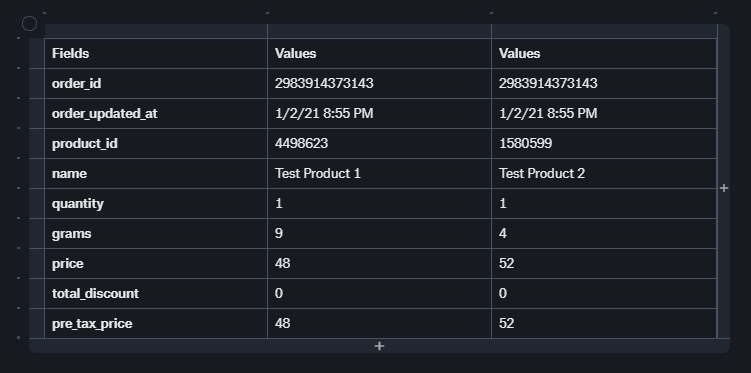Consider the following JSON. It is an anonymized extract from Shopify. It represents an order placed on the Shopify platform.
The use case is to obtain the tax_line information and associate it to the parent order_id of 6444275957783and the line item IDs of 6444275990551 and 6444275957783.
{
"id": 2983914373143,
"email": "Test@gmail.com",
"closed_at": "2021-01-02T14:50:01-06:00",
"created_at": "2021-01-02T14:49:59-06:00",
"updated_at": "2021-01-02T14:55:01-06:00",
"line_items": [{
"id": 6444275957783,
"quantity": 1,
"product_id": 4498623,
"name": "Test Product 1",
"grams": 9,
"price": "48.00",
"total_discount": "0.00",
"pre_tax_price": "48.00"
},
{
"tax_lines": [{
"title": "TN COUNTY TAX",
"price": "1.08",
"rate": 0.0225
},
{
"title": "TN STATE TAX",
"price": "3.36",
"rate": 0.07
},
{
"title": "TN CITY TAX",
"price": "0.00",
"rate": 0
}
]
},
{
"id": 6444275990551,
"quantity": 1,
"product_id": 1580599,
"name": "Test Product 2",
"grams": 4,
"price": "52.00",
"total_discount": "0.00"
},
{
"tax_lines": [{
"title": "STATE TAX",
"price": "3.64",
"rate": 0.07
},
{
"title": "CITY TAX",
"price": "0.00",
"rate": 0
},
{
"title": "COUNTY TAX",
"price": "1.17",
"rate": 0.0225
}
]
}
]
}
Using Mitto Store jobs it is straightforward to get the top level Order information. Contained within the JSON is the second level “line_items” node. It is also straightforward to get this information using a standard Mitto Store job.
The “line_items” node is referenced in the jpath and the parent order_id and order_updated_at fields are referenced in the “members” section of the “input” node. The orders__line_items table will be output with extra order_id and order_updated_at fields so that the child line_items can be linked up to the parent id.
{
"input":{
"jpath":"$.line_items[*]",
"members":[
{
"name":"order_id",
"value":"$.id"
},
{
"name":"order_updated_at",
"value":"$.updated_at"
}
],
"name":"shopify_orders",
"use":"mitto.iov2.input#StoreInput"
},
"output":{
"dbo":"postgresql://localhost/analytics",
"schema":"shopify",
"tablename":"orders__line_items",
"use":"call:mitto.iov2.db#todb"
},
"steps":[
{
"column":"order_updated_at",
"use":"mitto.iov2.steps#MaxTimestamp"
},
{
"use":"mitto.iov2.steps.upsert#SetUpdatedAt"
},
{
"transforms":[
{
"use":"mitto.iov2.transform#ExtraColumnsTransform"
},
{
"use":"mitto.iov2.transform#ColumnsTransform"
}
],
"use":"mitto.iov2.steps#Input"
},
{
"use":"mitto.iov2.steps#CreateTable"
},
{
"use":"mitto.iov2.steps.upsert#CreateTempTable"
},
{
"transforms":[
{
"use":"mitto.iov2.transform#FlattenTransform"
}
],
"use":"mitto.iov2.steps#Output"
},
{
"key":"id",
"use":"mitto.iov2.steps.upsert#SyncTempTable"
},
{
"use":"mitto.iov2.steps#CollectMeta"
}
]
}
This will create a shopify.orders__line_items table that will contain the following information:
Extracting the “tax_lines” Node
However for each of the line_item nodes there is a third le. In this example we will look at the “tax_lines” node. For each line item these is an individual tax charged. To get this third level of information out of the JSON and to be able to reference the tax_line to the parent line_item, the Pluck V2 method needs to be used.
To set this up we again use the “use”: “mitto.iov2.input#StoreInput” input method.
"input":{
"jpath":"$.line_items[*]",
"members":[
{
"name":"order_id",
"value":"$.id"/*Order ID 2983914373143*/
},
{
"name":"order_updated_at",
"value":"$.updated_at""/*Updated at 2021-01-02T14":"55":"01-06":00*/
}
],
"name":"shopify_orders",
"use":"mitto.iov2.input#StoreInput"
},
The “members” section of the input node specifies our grandparent IDs (and any other important fields, in this case, “updated_at”). These are highest level fields in the JSON.
These specified fields are then referenced in the “transforms” node below.
The “members” node in the “transforms” node makes reference to the “order_id” and “order_updated_at” that was created in the “input” “member” node.
Then a new reference to the line item id (from $.line_items[*].$.id) is then made.
{
"input": {
"jpath": "$.line_items[*]",
"members": [
{
"name": "order_id",
"value": "$.id"
},
{
"name": "order_updated_at",
"value": "$.updated_at"
}
],
"name": "shopify_orders",
"use": "mitto.iov2.input#StoreInput"
},
"output": {
"dbo": "postgresql://localhost/analytics",
"schema": "shopify",
"tablename": "orders__line_items__tax_lines2",
"use": "call:mitto.iov2.db#todb"
},
"steps": [
{
"transforms": [
{
"jpath": "$.tax_lines[*]",
"members": [
{/* Reference to the input member node above*/
"name": "order_id",
"value": "$.order_id"
},
{/* Reference to the input member node above*/
"name": "order_updated_at",
"value": "$.order_updated_at"
},
{/* New Reference the line item id ie $.line_items[*].$.id*/
"name": "order_line_item_id",
"value": "$.id"
}
],
"use": "mitto.iov2.transform#PluckV2Transform"
},
{
"use": "mitto.iov2.transform#ExtraColumnsTransform"
},
{
"use": "mitto.iov2.transform#ColumnsTransform"
}
],
"use": "mitto.iov2.steps#Input"
},
{
"use": "mitto.iov2.steps#CreateTable"
},
{
"transforms": [
{
"use": "mitto.iov2.transform#FlattenTransform"
}
],
"use": "mitto.iov2.steps#Output"
},
{
"use": "mitto.iov2.steps#CollectMeta"
}
]
}
The output of this table is as follows:

